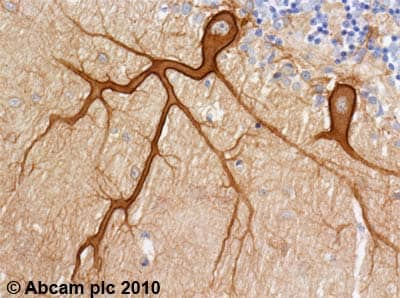Anti-PKC gamma antibody (ab71558)
Key features and details
- Rabbit polyclonal to PKC gamma
- Suitable for: ICC/IF, IHC-P, WB
- Reacts with: Mouse, Rat, Guinea pig, Human
- Isotype: IgG
Overview
-
Product name
Anti-PKC gamma antibody
See all PKC gamma primary antibodies -
Description
Rabbit polyclonal to PKC gamma -
Host species
Rabbit -
Tested applications
Suitable for: ICC/IF, IHC-P, WBmore details -
Species reactivity
Reacts with: Mouse, Rat, Guinea pig, Human -
Immunogen
Synthetic peptide. This information is proprietary to Abcam and/or its suppliers.
-
Positive control
- Hela, A431 cell lysate and mouse, rat brain lysate.
-
General notes
The Life Science industry has been in the grips of a reproducibility crisis for a number of years. Abcam is leading the way in addressing this with our range of recombinant monoclonal antibodies and knockout edited cell lines for gold-standard validation. Please check that this product meets your needs before purchasing.
If you have any questions, special requirements or concerns, please send us an inquiry and/or contact our Support team ahead of purchase. Recommended alternatives for this product can be found below, along with publications, customer reviews and Q&As
Properties
-
Form
Liquid -
Storage instructions
Shipped at 4°C. Upon delivery aliquot and store at -20°C or -80°C. Avoid repeated freeze / thaw cycles. -
Storage buffer
Preservative: 0.03% Sodium azide
Constituents: 0.87% Sodium chloride, HEPES, 0.01% BSA, 50% Glycerol (glycerin, glycerine) -
 Concentration information loading...
Concentration information loading... -
Purity
Protein A purified -
Clonality
Polyclonal -
Isotype
IgG -
Research areas
Images
-
All lanes : Anti-PKC gamma antibody (ab71558) at 1/2000 dilution
Lane 1 : Hela cell lysate
Lane 2 : A431 cell lysate
Lane 3 : Mouse brain lysate
Lane 4 : Rat brain lysate
Predicted band size: 78 kDa
Observed band size: 78 kDa
Additional bands at: 34 kDa, 40 kDa, 66 kDa. We are unsure as to the identity of these extra bands.
-
 Immunohistochemistry (Formalin/PFA-fixed paraffin-embedded sections) - Anti-PKC gamma antibody (ab71558)ab71558 (1µg/ml) staining PKCg in human Brain: Cerebellum using an automated system (DAKO Autostainer Plus). Using this protocol there is cytoplasmic and membrane staining of neuropil, molecular cells and Purkinje cells.
Immunohistochemistry (Formalin/PFA-fixed paraffin-embedded sections) - Anti-PKC gamma antibody (ab71558)ab71558 (1µg/ml) staining PKCg in human Brain: Cerebellum using an automated system (DAKO Autostainer Plus). Using this protocol there is cytoplasmic and membrane staining of neuropil, molecular cells and Purkinje cells.
Sections were rehydrated and antigen retrieved with the Dako 3 in 1 AR buffer EDTA pH 9.0 in a DAKO PT Link. Slides were peroxidase blocked in 3% H2O2 in methanol for 10 mins. They were then blocked with Dako Protein block for 10 minutes (containing casein 0.25% in PBS) then incubated with primary antibody for 20 min and detected with Dako Envision Flex amplification kit for 30 minutes. Colorimetric detection was completed with Diaminobenzidine for 5 minutes. Slides were counterstained with Haematoxylin and coverslipped under DePeX. Please note that, for manual staining, optimization of primary antibody concentration and incubation time is recommended. Signal amplification may be required.
-
ICC/IF image of ab71558 stained Hepp cells. The cells were 4% formaldehyde fixed (10 min) and then incubated in 1%BSA / 10% normal goat serum / 0.3M glycine in 0.1% PBS-Tween for 1h to permeabilise the cells and block non-specific protein-protein interactions. The cells were then incubated with the antibody (ab71558, 5µg/ml) overnight at +4°C. The secondary antibody (green) was Alexa Fluor® 488 goat anti-rabbit IgG (H+L) used at a 1/1000 dilution for 1h. Alexa Fluor® 594 WGA was used to label plasma membranes (red) at a 1/200 dilution for 1h. DAPI was used to stain the cell nuclei (blue) at a concentration of 1.43µM.










